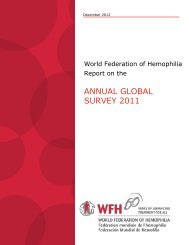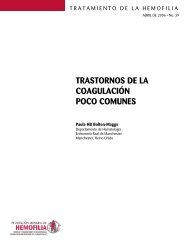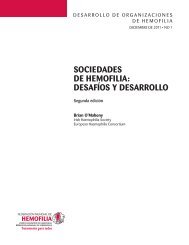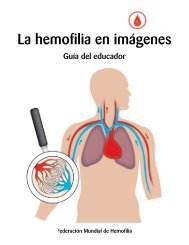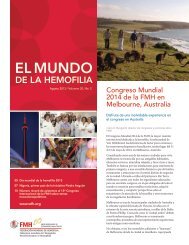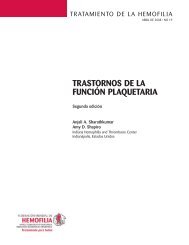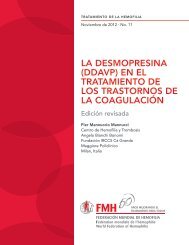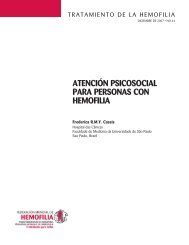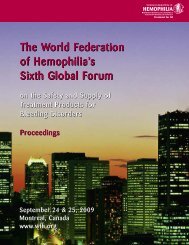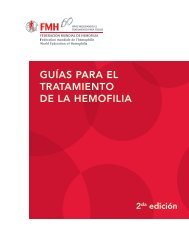Guide for the Assessment of Clotting Factor Concentrates
Guide for the Assessment of Clotting Factor Concentrates
Guide for the Assessment of Clotting Factor Concentrates
You also want an ePaper? Increase the reach of your titles
YUMPU automatically turns print PDFs into web optimized ePapers that Google loves.
Table 2: Advantages and o<strong>the</strong>r points to consider when selecting viral reduction treatments<strong>of</strong> factor concentratesTreatment Advantages Points to considerSolvent-detergent (SD)Treatment with a mixture <strong>of</strong> chemicals – solventsand detergents – which inactivate virusesthrough removal <strong>of</strong> <strong>the</strong> lipid envelope whichcoats some types <strong>of</strong> viruses. Hence it is noteffective against agents which lack this envelope. Extremely efficient againstenveloped viruses Relatively simple equipment Non denaturing effect on proteins High recovery <strong>of</strong> protein functionalactivity Requires a subsequentmanufacturing step toeliminate <strong>the</strong> SD agents Not effective against nonenvelopedviruses, e.g. B19or HAVPasteurisationThis is a generic term <strong>for</strong> heat treatment <strong>of</strong> aprotein in solution at 60 o C <strong>for</strong> 10 hours. Itsefficacy in inactivating viruses is dependent on<strong>the</strong> exact conditions under which it is per<strong>for</strong>med.When it is used to treat proteins which arefragile, such as clotting factors, <strong>the</strong> solution hasto include protective chemicals so as to preserve<strong>the</strong> protein; <strong>the</strong>se may also preserve <strong>the</strong> virus. Potential to inactivate envelopedand non-lipid enveloped viruses,including HAV. Each processneeds to be evaluated on <strong>the</strong>basis <strong>of</strong> <strong>the</strong> data submitted by<strong>the</strong> manufacturer. Relatively simple equipment Dependent on conditions Protein stabilizers mayprotect viruses Does not inactivate B19 Low recovery <strong>of</strong> fragilecoagulation factors Potential generation <strong>of</strong>neoantigensVapor-heatCurrently restricted to one manufacturer. May inactivate enveloped andnon-enveloped viruses, includingHAV Possible risk <strong>of</strong> transmission<strong>of</strong> HCV and HBV Does not inactivate B19Terminal dry-heat This involves heating <strong>the</strong> final product in<strong>the</strong> lyophilized state in <strong>the</strong> container used toissue and reconstitute <strong>the</strong> concentrate. Theefficacy <strong>of</strong> viral kill is strongly dependent on<strong>the</strong> exact combination <strong>of</strong> time and temperaturewhich <strong>the</strong> product is exposed to. These conditionshave been described by manufacturers: May inactivate enveloped andnon enveloped viruses, includingHAV Treatment applied on <strong>the</strong> finalcontainer Does not inactivate B19 10 to 20% loss <strong>of</strong> coagulationfactor activity Requires strict control <strong>of</strong>residual moisture content60 o C <strong>for</strong> 72 hours80 o C <strong>for</strong> 72 hours100 o C <strong>for</strong> 30 minutes100 o C <strong>for</strong> 120 minutes65 o C <strong>for</strong> 96 hoursFor example, 60 o C is known to be less effectivethan 80 o C <strong>for</strong> similar lengths <strong>of</strong> time. Eachprocess needs to be evaluated on <strong>the</strong> basis <strong>of</strong><strong>the</strong> data submitted by <strong>the</strong> manufacturer.8 <strong>Guide</strong> <strong>for</strong> <strong>the</strong> <strong>Assessment</strong> <strong>of</strong> <strong>Clotting</strong> <strong>Factor</strong> <strong>Concentrates</strong>



